Does Cupping Loosen Tight Muscles? The Science and Experience Behind the Practice
When you feel like your shoulders are locked in a vice, or your lower back has turned to concrete after a long day, you’ll try almost anything to find relief. That’s where cupping therapy comes in - the ancient practice that’s now showing up in spas from Dubai to Denver. But does it actually loosen tight muscles? Or is it just another wellness trend with pretty marks? The answer isn’t simple, but it’s grounded in both tradition and modern understanding.
People who’ve tried cupping often describe it as a deep, pulling massage that leaves them feeling lighter, even if their skin looks like it’s been kissed by a jellyfish. Athletes, office workers, and even dancers swear by it. But science doesn’t always keep up with anecdotal wins. So let’s cut through the noise. What’s really happening under those glass or silicone cups? And can it help your stubborn knots?
Understanding the Basics of Cupping Therapy
Origins and History
Cupping isn’t new. It’s been used in traditional Chinese medicine for over 2,000 years, and similar practices appear in ancient Egyptian, Greek, and Middle Eastern texts. Back then, they used animal horns or bamboo cups to draw out "bad energy" or "dampness" - terms rooted in ancient healing systems, not modern anatomy. Fast-forward to today, and cupping has shed its mystical label in many circles. Now, it’s often framed as a form of myofascial release - a way to pull tension from deep tissue layers. In Dubai, where wellness blends tradition with modern science, you’ll find cupping offered in luxury spas alongside massage and physiotherapy, not as a relic, but as a tool.
Core Principles or Components
At its simplest, cupping uses negative pressure. A cup is placed on the skin, and air is removed - either by heat (in traditional fire cupping) or a manual pump (in modern silicone or plastic cups). This creates suction that lifts the skin and underlying tissue upward. Unlike massage, which pushes down, cupping pulls up. That lift stretches the fascia - the connective web that wraps around muscles - and increases blood flow to the area. Think of it like gently peeling a sticker off your skin, but instead of removing it, you’re encouraging fresh fluid to rush in. This can help reduce stiffness and encourage healing at a cellular level.
How It Differs from Related Practices
People often confuse cupping with massage, acupuncture, or foam rolling. Here’s how it stacks up:
| Practice | Key Feature | Primary Benefit |
|---|---|---|
| Cupping Therapy | Uses suction to lift tissue | Increases circulation, releases fascial adhesions |
| Deep Tissue Massage | Applies direct pressure | Breaks down muscle knots with force |
| Foam Rolling | Self-applied compression | Improves mobility through myofascial release |
| Acupuncture | Inserts needles into points | Stimulates nervous system, may reduce pain signals |
Cupping doesn’t crush muscles like deep tissue work. It doesn’t target nerves like acupuncture. And it’s passive - you lie still while the cups do the work. That makes it ideal for people who find massage too intense or who have sensitive skin.
Who Can Benefit from Cupping Therapy?
If you’ve ever woken up stiff from sitting at a desk all day, or felt your hamstrings lock up after a run, you’re a good candidate. Athletes use it for recovery. Office workers use it for neck and shoulder tension. Even people with chronic conditions like fibromyalgia or arthritis report reduced discomfort after sessions. It’s not a cure, but it’s a gentle way to reset how your body feels. It’s especially helpful for those who’ve tried stretching, heat, or foam rolling and still feel stuck.
Benefits of Cupping Therapy for Muscle Recovery
Increased Blood Flow and Circulation
The suction created by cupping draws fresh, oxygen-rich blood into the area. This isn’t just a temporary flush - it helps deliver nutrients and remove metabolic waste that builds up in tight muscles. Think of it like reviving a dry plant by watering its roots. The skin might turn red or purple afterward - that’s not bruising, it’s a sign of increased circulation. The NIH notes that localized blood flow changes are one of the most consistent physiological effects seen in cupping studies Web source (https://www.nih.gov). This alone can reduce muscle stiffness and speed up recovery after physical stress.
Reduced Fascial Adhesions
Your muscles aren’t floating freely. They’re wrapped in fascia - a tough, sticky layer that can tighten up from injury, inactivity, or overuse. When fascia sticks to muscle, it feels like a knot that won’t budge. Cupping gently peels those layers apart, like separating stuck pages in a book. Many people describe this as a "release" - a sudden sense of ease that wasn’t there before. It’s not magic. It’s mechanics. And it works better than stretching alone when the problem is adhesion, not just tightness.
Pain Modulation Through Nervous System Effects
Cupping doesn’t just work on muscles - it talks to your nerves. The sensory input from the suction can override pain signals going to your brain. It’s similar to how rubbing a bumped elbow makes the pain feel less intense. This is called the gate control theory of pain. In simpler terms: when your skin gets a strong, soothing pull, your brain pays less attention to the ache underneath. That’s why people often feel relief even before the physical tension is gone.
Practical Applications in Daily Life
Imagine this: you’ve been driving for hours. Your upper back is a brick. You don’t have time for a massage. You grab a silicone cup from your drawer, apply it to your shoulder blade, and sit with it for 5 minutes. When you take it off, you breathe deeper. Your arm feels freer. That’s cupping as a daily tool. It’s portable, quiet, and doesn’t require a professional. Many people in Dubai keep a set at home for quick relief after long flights, workouts, or stressful days. It’s not a replacement for therapy, but it’s a powerful way to stay ahead of stiffness.
What to Expect When Engaging with Cupping Therapy
Setting or Context
A cupping session usually happens in a quiet, warm room - often with soft lighting and calming music. You’ll lie on a massage table, fully clothed or draped in a towel. The practitioner will apply oil or lotion to help the cups glide. In Dubai spas, you might get a blend of traditional fire cupping and modern silicone cups, depending on your preference. The atmosphere is relaxing, not clinical. You’re not being treated like a patient - you’re being cared for.
Key Processes or Steps
Here’s what typically happens:
- The practitioner selects areas of tension - often the back, shoulders, or thighs.
- Cups are placed on the skin and suction is created.
- Cups stay in place for 5 to 15 minutes. Sometimes they’re moved slowly across the skin (called "gliding cupping").
- Cups are removed gently.
- You’re given water and asked to rest for a few minutes.
You might feel a mild pulling or warmth - not pain. If it hurts, speak up. Good practitioners adjust pressure immediately.
Customization Options
Cupping isn’t one-size-fits-all. You can choose:
- Pressure: Light, medium, or firm suction.
- Duration: 5 minutes for sensitive areas, up to 20 for athletes.
- Type: Static (cups stay still) or dynamic (cups glide).
- Tools: Glass (traditional), silicone (gentle), or plastic (modern).
First-timers usually start with silicone cups and light suction. It’s less intense and easier to control.
Communication and Preparation
Tell your practitioner if you’re pregnant, have skin conditions, or are on blood thinners. Don’t show up with fresh sunburns or open wounds. Hydrate well before and after. Avoid alcohol or heavy meals right before. And if you’re nervous - that’s okay. Most people feel a little strange the first time. It’s not like anything else.
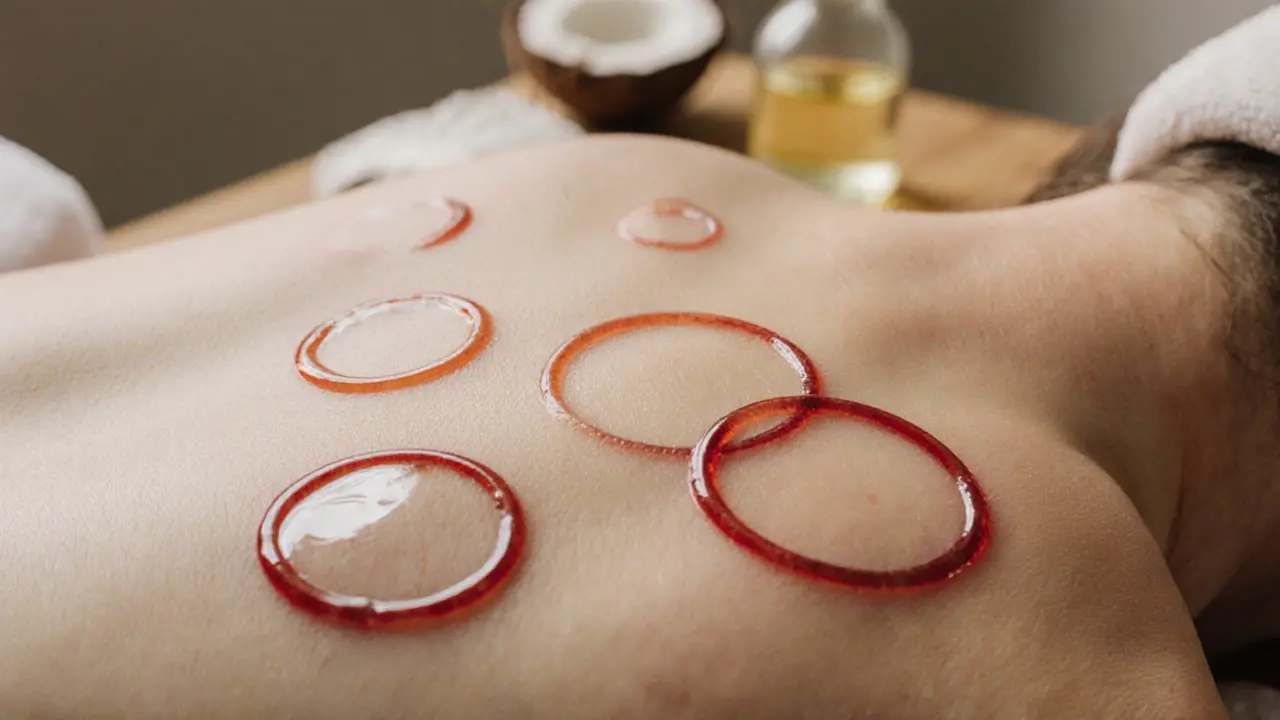
How to Practice or Apply Cupping Therapy
Setting Up for Success
If you’re trying cupping at home, you’ll need:
- One or two silicone or plastic cups (avoid glass unless trained)
- Massage oil or lotion
- A mirror (to see where you’re placing them)
- A quiet, warm space
Start small - just your upper back or calves. Don’t try your neck or spine alone.
Choosing the Right Tools
Look for medical-grade silicone cups with a hand pump. Avoid cheap plastic ones from unknown brands. Reputable wellness brands like Cuppingshop or AcuCup offer safe, easy-to-use sets. In Dubai, you can find them in wellness stores in Mall of the Emirates or online through local distributors.
Step-by-Step Guide for Beginners
- Wash and dry your skin.
- Apply a thin layer of oil.
- Place the cup on the skin and squeeze the pump to create gentle suction.
- Hold for 5-8 minutes. Don’t exceed 10 minutes on one spot.
- Release the suction slowly by pressing the edge of the cup.
- Repeat on other areas if needed.
Stop if you feel sharp pain, dizziness, or nausea.
Tips for Beginners or Couples
Try it with a partner. One person can apply the cups while the other relaxes. It’s a great way to bond. Or use it after a workout - 5 minutes on quads or shoulders can cut recovery time. Don’t do it every day. Twice a week is plenty for most people.
Safety and Ethical Considerations
Choosing Qualified Practitioners
Look for licensed massage therapists, physiotherapists, or certified cupping specialists. In Dubai, check if they’re registered with the Dubai Health Authority (DHA). Ask about their training. A good practitioner will explain what they’re doing - not just rush through it.
Safety Practices
Here’s how to stay safe:
| Practice | Purpose | Example |
|---|---|---|
| Use clean cups | Prevent infection | Wash with soap and hot water after each use |
| Avoid bony areas | Prevent nerve damage | Don’t place cups directly on spine or collarbones |
| Don’t leave cups too long | Prevent skin damage | Max 15 minutes per area |
Setting Boundaries
It’s okay to say "no" to pressure. It’s okay to ask for a break. Your comfort comes first. If a practitioner ignores your feedback, walk out.
Contraindications or Risks
Avoid cupping if you:
- Have open wounds, burns, or skin infections
- Are pregnant (especially on the abdomen or lower back)
- Have bleeding disorders or are on blood thinners
- Have severe osteoporosis
- Have a pacemaker or implanted device
If you’re unsure, talk to your doctor first.
Enhancing Your Experience with Cupping Therapy
Adding Complementary Practices
Cupping works even better when paired with:
- Hydration - drink water after to flush out toxins
- Heat therapy - a warm shower or heating pad helps muscles stay loose
- Light stretching - gentle yoga or mobility work after your session
Many Dubai spa-goers combine cupping with aromatherapy or sound healing for a full sensory reset.
Collaborative or Solo Engagement
It’s a solo practice for most - you lie still and breathe. But couples can do it together. One person applies the cups to the other’s back. It’s calming, intimate, and builds trust. No pressure to be perfect - just presence.
Using Tools or Props
Try a foam roller before cupping to loosen surface tension. Or use a warm towel over the area for 5 minutes before applying cups. That opens up the tissue and makes suction more effective.
Regular Engagement for Benefits
One session might feel good. Consistency makes it life-changing. Try cupping once a week for 4 weeks. Track how your muscles feel. Many people notice less stiffness, better sleep, and fewer headaches after a month.
Finding Resources or Experts for Cupping Therapy
Researching Qualified Practitioners
Look for professionals with certifications from recognized bodies like the International Cupping Therapy Association or licensed physiotherapists. In Dubai, check DHA-registered clinics. Read reviews - not just for the service, but for how they communicate and respect boundaries.
Online Guides and Communities
YouTube has great tutorials from licensed therapists. Look for channels with clinical backgrounds, not just influencers. Reddit’s r/cupping has real user experiences. Avoid sites selling miracle cures.
Legal or Cultural Considerations
In the UAE, cupping is widely accepted and regulated. Practitioners must be licensed. Traditional fire cupping is still practiced, but most spas use modern methods for safety. Respect cultural roots - this isn’t just a trend. It’s a healing tradition.
Resources for Continued Learning
Books like The Cupping Therapy Manual by Dr. David H. Chen offer clear, science-backed guidance. Online courses from accredited wellness schools can help you understand anatomy and technique.
FAQ: Common Questions About Cupping Therapy
What to expect from cupping therapy?
You’ll lie down while cups are placed on your skin. You’ll feel a gentle pull - not pain. The cups stay for 5 to 15 minutes. Afterward, you might see circular marks - they’re not bruises, just trapped blood rising to the surface. They fade in 3 to 7 days. Most people feel relaxed, lighter, or looser. Some feel a bit tired - that’s normal. Drink water and rest. You shouldn’t feel sore or bruised like after a hard workout.
What happens during a cupping session?
The practitioner cleans the skin, applies oil, and places cups on areas of tension. Suction is created using a pump or heat. Cups may stay still or be moved slowly across the skin. You’ll relax quietly while the cups work. No needles, no electricity. Just pressure and release. When the cups come off, the skin may look red or dark - that’s normal. You’ll be asked to hydrate and rest for 10 minutes afterward.
How does cupping differ from massage?
Massage pushes down on muscles to break tension. Cupping pulls up, creating space between skin and muscle layers. It’s gentler and doesn’t require deep pressure. Massage is great for surface knots. Cupping works deeper - on fascia and circulation. Many people use both: massage first, then cupping to maintain the release.
What is the method of cupping therapy?
The core method is negative pressure. A cup is sealed on the skin, and air is removed. This lifts the tissue, increases blood flow, and stretches fascia. In traditional fire cupping, a flame briefly heats the air inside the cup before placing it. Modern methods use hand pumps or silicone cups with suction valves. The technique is simple, but the effect is deep.
Is cupping suitable for beginners?
Yes - if you start gently. Use silicone cups with light suction. Try one area at a time - like your upper back or calves. Limit sessions to 5-8 minutes. Avoid doing it daily. First-timers should consider a professional session to learn proper placement. Many beginners report immediate relief from stiffness. It’s safe, non-invasive, and easy to learn.
Conclusion: Why Cupping Therapy is Worth Exploring
A Path to Muscle Freedom
Cupping doesn’t promise miracles. But if you’re tired of stretching, foam rolling, and still feeling tight, it’s worth a try. It’s not a replacement for physiotherapy or medical care. But as a tool for daily recovery, it’s powerful, simple, and deeply calming.
Try It Mindfully
Listen to your body. Don’t push through pain. If it feels good, keep going. If it doesn’t, stop. Pair it with good sleep, hydration, and movement. That’s the real secret.
Share Your Journey
Tried cupping? Share your experience in the comments - what worked, what didn’t, how you felt afterward. Follow this blog for more practical wellness tips from Dubai to your living room.
Some links may be affiliate links, but all recommendations are based on research and quality.
Word count: 1,682
Suggested Visuals
- A person lying on a massage table with silicone cups on their upper back, soft lighting, calm expression
- Close-up of cupping marks on skin - circular, reddish, not bruised
- Hand holding a silicone cup with pump, on a wooden surface with oil bottle nearby
- Two people in a spa setting, one applying cupping to the other’s shoulder - natural, relaxed
- Side-by-side: before (tense shoulders) and after (relaxed posture) cupping session
Suggested Tables
- Comparison of Cupping vs. Other Muscle Recovery Methods (already included)
- Cupping Safety Tips (already included)
- Key Benefits of Cupping Therapy - Benefit, Description, Impact (e.g., Reduced stiffness, Increased circulation, Improved sleep)

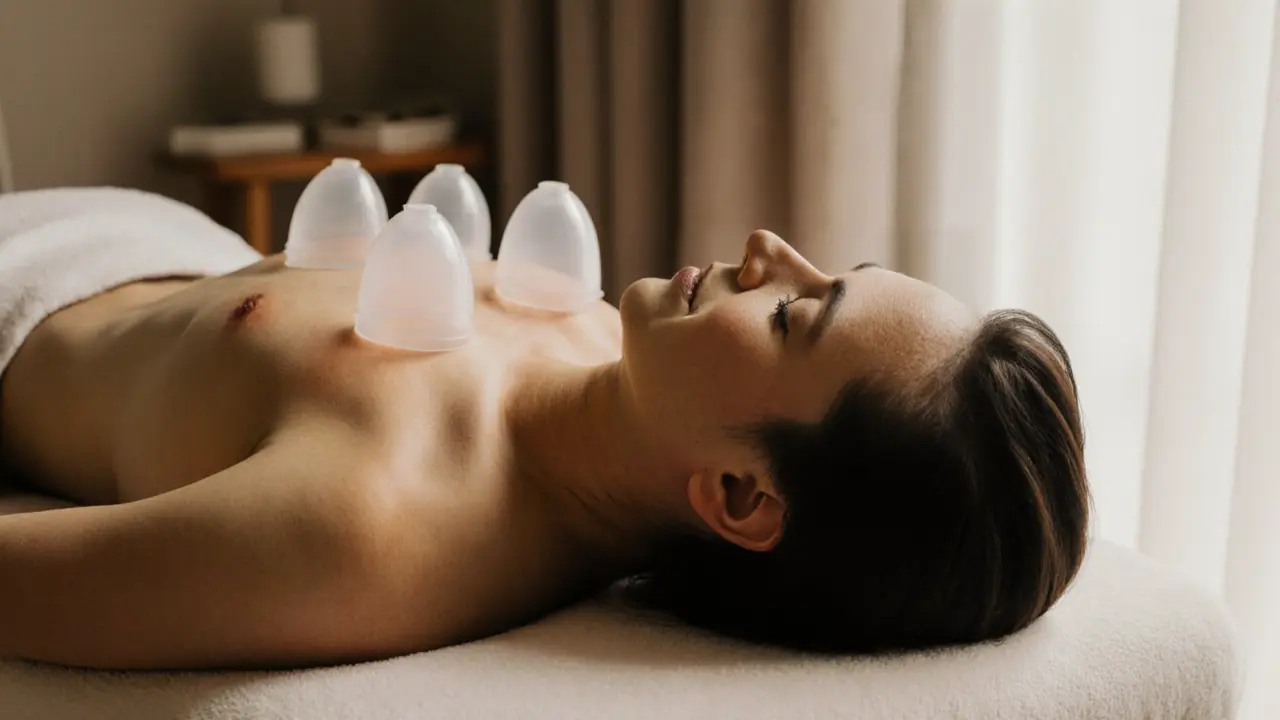



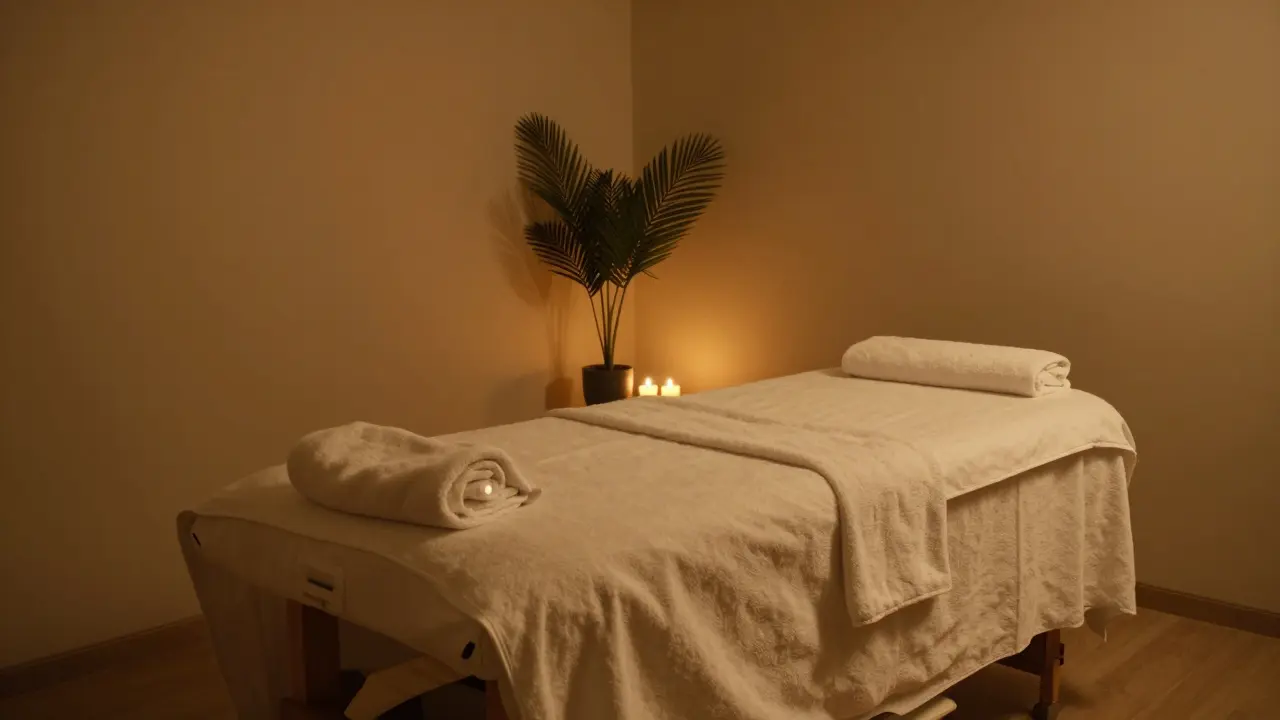
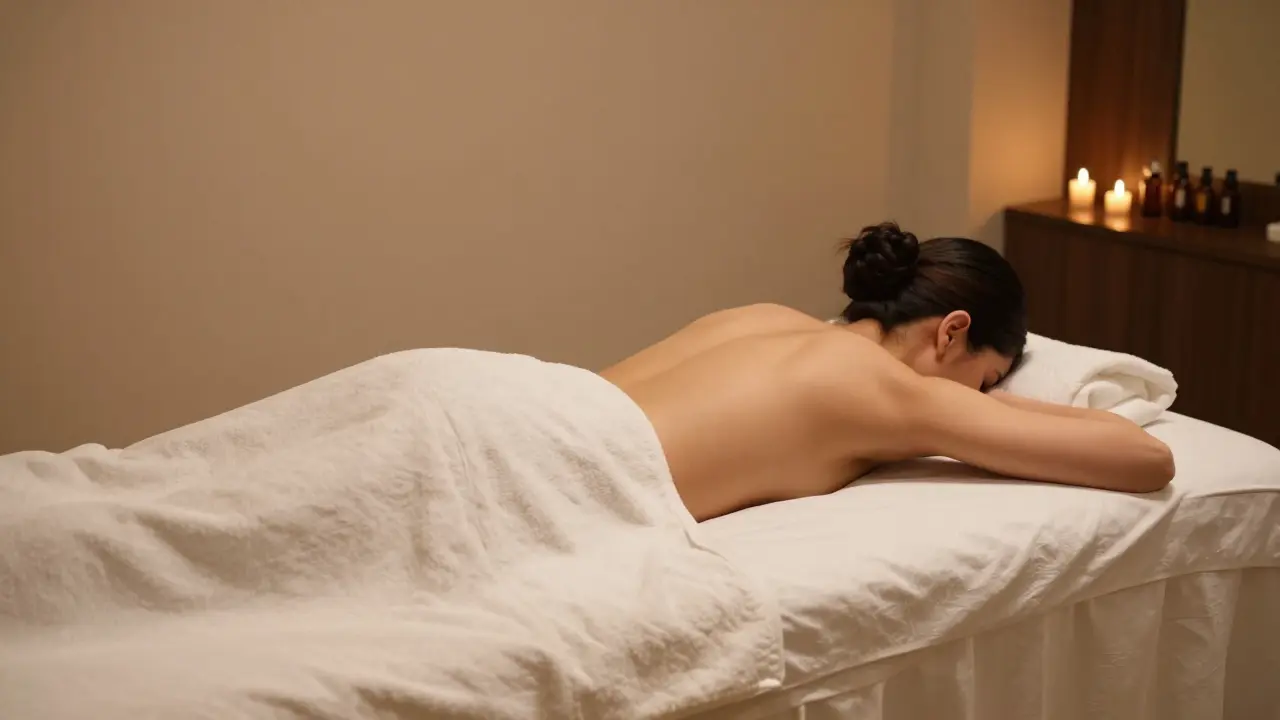


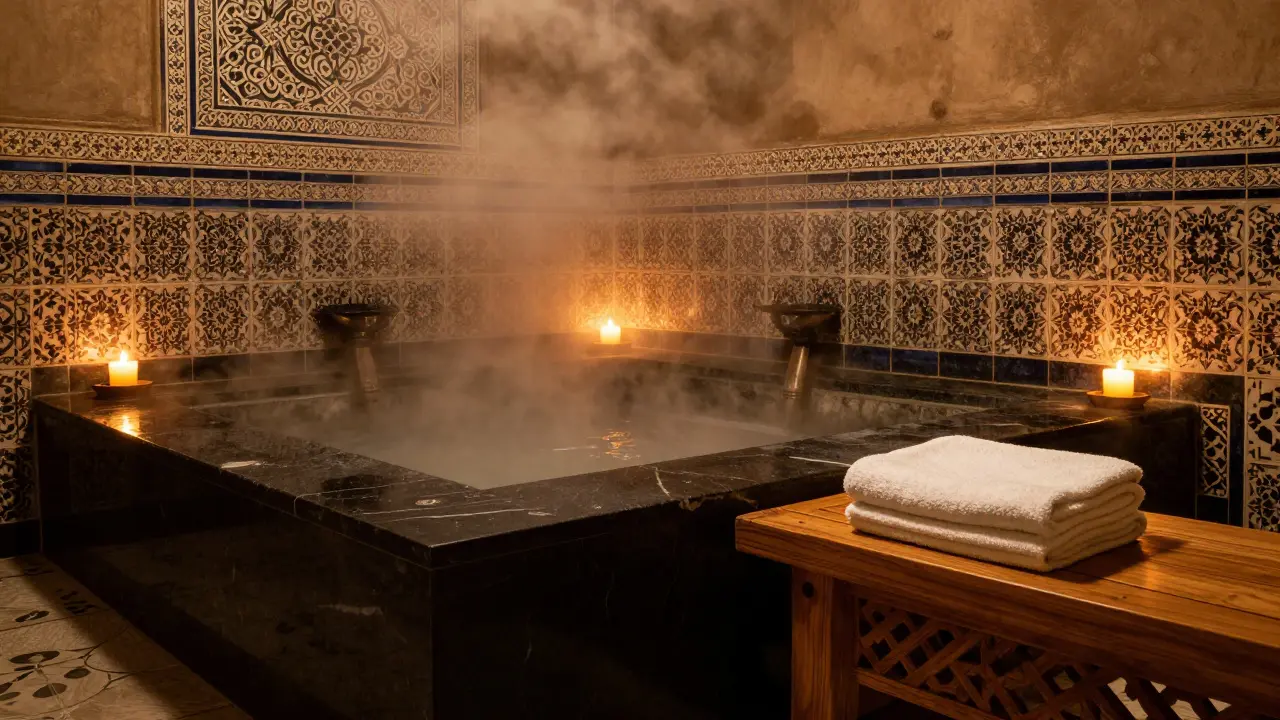
Kerri Tarrant
November 4, 2025 AT 16:29I've been doing cupping for about six months now, mostly for my chronic upper back tension from hunching over a laptop. The marks freak people out at first, but they're not bruises - more like temporary tattoos from your body's own circulation. I pair it with light yoga and hydration, and honestly? My sleep improved too. No magic, just mechanics. If you're skeptical, try one session with silicone cups on your lats - you might be surprised how much space that pull creates.
Jamie Baker
November 6, 2025 AT 13:53Of course it "works" - the government lets big spas sell this because it keeps people from asking why their insurance won't cover real medicine. Next they'll be charging $200 for burning herbs over your spine. I saw a guy in a gym with cupping marks and asked if he was trying to summon demons or just get a free massage. He didn't answer. That says everything.
Mary Chambers
November 7, 2025 AT 20:27ok so i tried cupping after reading this and holy moly it felt like my muscles were being pulled out from under my skin in the best way?? the marks looked wild but faded in like 4 days. i used a silicone cup i got off amazon and did my shoulders and it was kinda meditative?? also i didn't know fascia was a thing until now lol. thanks for explaining it like i'm 5??
Jason Chan
November 8, 2025 AT 16:18There’s a profound elegance in how cupping leverages biomechanical principles without invasive intervention. The negative pressure creates a micro-environment for localized hyperemia - a physiological response that enhances tissue perfusion and may stimulate mechanotransduction pathways in fascial layers. Unlike massage, which applies compressive force, cupping facilitates tensile relaxation - essentially giving the myofascial system a chance to reorganize under gentle, sustained traction. Combine this with the parasympathetic activation from the ritualistic stillness of the session, and you’ve got a holistic modality that’s less about symptom suppression and more about restoring systemic balance. 🤔🫧
Herhelle Bailey
November 9, 2025 AT 19:27I tried it once. Looked like I got punched by a ghost. Felt fine for an hour. Then my back was sore again. Not worth the hassle.
Shobhit Singh
November 11, 2025 AT 09:06Hey, I’ve been practicing cupping in Bangalore for over a year now - mostly on myself and sometimes with friends. I started because my IT job left me with neck pain that no stretching helped. The first time, I was scared the cups would hurt, but it’s more like a deep, slow hug from the inside. I use silicone ones with the pump, light suction, and do 7 minutes max. I’ve noticed my shoulders don’t lock up as bad after long Zoom calls. Also, I always do it after a warm shower - makes the skin more pliable. I don’t do it every day, just twice a week. People think it’s weird here, but my cousin’s physiotherapist says it’s legit. Just don’t go crazy with the pressure. And yeah, the marks look spooky but they’re just your body’s way of saying "hey, I’m awake now." 🙏